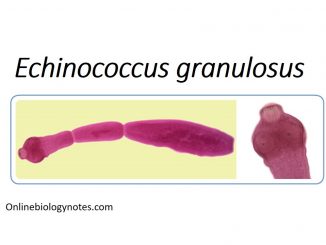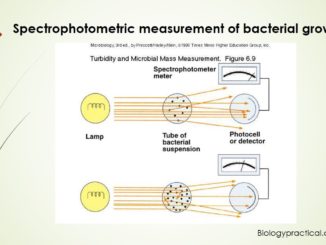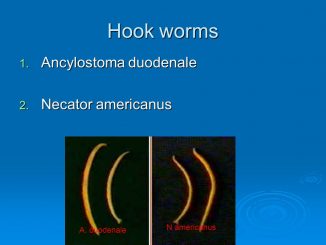
Echinococcus granulosus (Dog tapeworm)
Echinococcus granulosus also termed as the hydatid worm or Hyper tapeworm or Dog Tapeworm. It is a cyclophyllid cestode that parasites the small intestine of […]

Echinococcus granulosus also termed as the hydatid worm or Hyper tapeworm or Dog Tapeworm. It is a cyclophyllid cestode that parasites the small intestine of […]

Principle: The quantitative detection of the bacterial population is needed for various studies. There are basically two methods used for the counting of bacterial population […]

Principle: There are various techniques/methodologies for the enumeration (counting) of bacteria in a given sample. A viable cell count permits to detect the number of […]

Objectives: To prepare streptomycin gradient agar plate To isolate streptomycin resistant variant of E. coli Principle: A microorganism that manifests a natural, nonmutated inheritance is […]

Principle: The febrile antibody test is applicable in the diagnosis of diseases that produce febrile (fever) symptoms. Some of the microorganisms that accounts for febrile […]

Visceral leishmaniasis (VL) or Kala-azar: Visceral Leishmaniasis (VL) also known as kala-azar or black fever or dum-dum fever, is the most severe form of leishmaniasis. […]

Precipitation ring test Principle: The ring or interfacial test is a simple serological method that exemplifies the precipitin reaction in solution. This antigen-antibody reaction can […]

Ancyclostoma duodenale VS Necator americanus S.N Characteristics of adult worm Ancylostoma Duodenales Necator americanus 1 Pathogenicity More pathogenic Less pathogenic 2 size Larger and thick […]

Hookworms: Hookworms are parasitic nematode that lives in the small intestine of mammalian host such as dog, cat or humans. They are characterized by their […]

Dracunculus medinensis Dracunuculus medinensis is among the longest nematodes affecting humans. It is also known as Guinea worm, Medina worm, serpent worm or dragon worm. […]
Copyright © 2024 | WordPress Theme by MH Themes